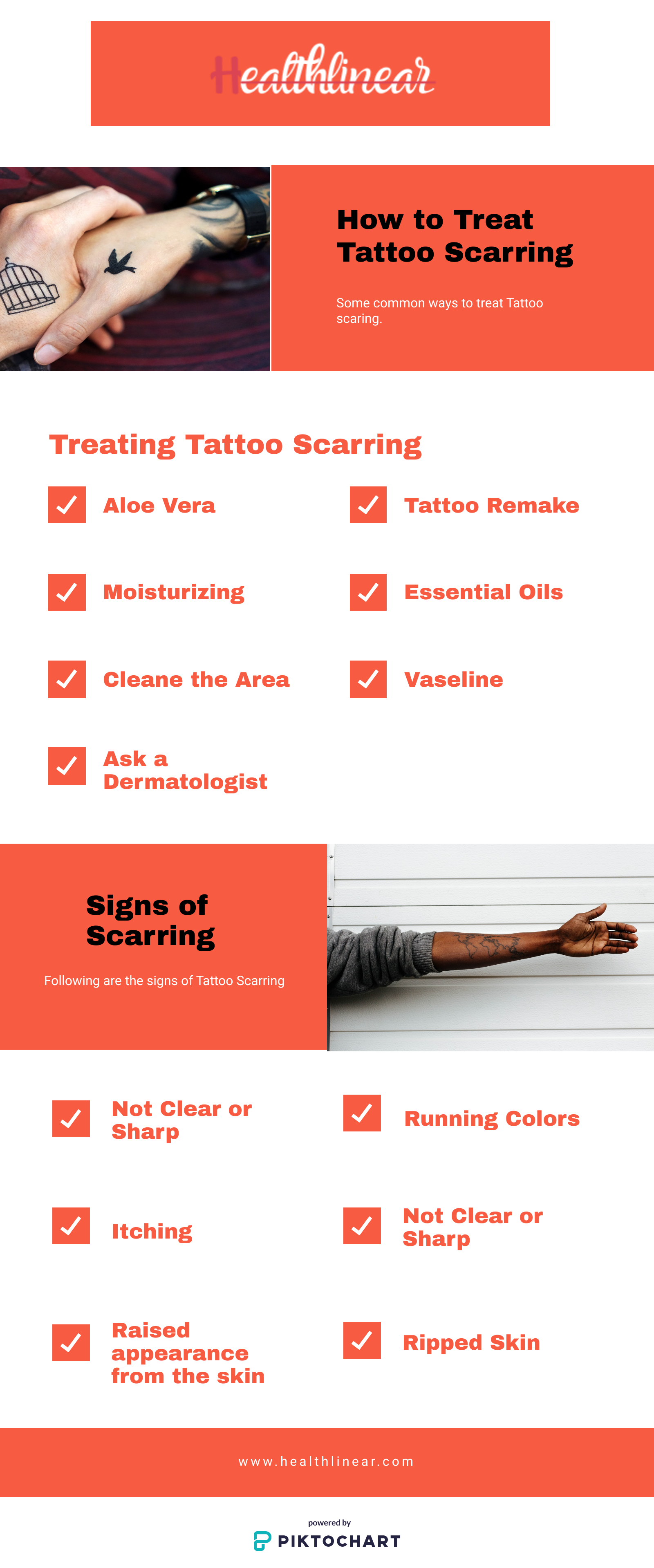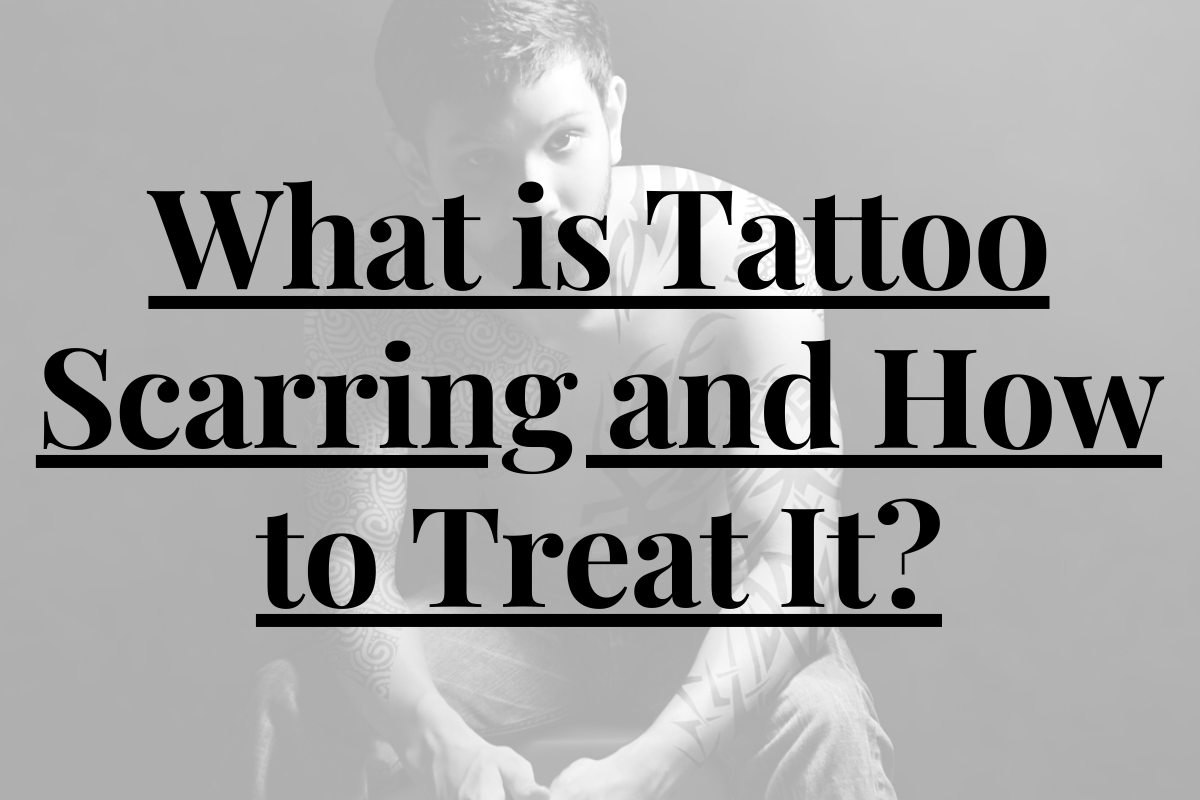There is always a possibility of experiencing tattoo scarring when one decides to get a tattoo. Tattoo scarring can occur during the drawing process as well as the healing of a tattoo. It may also form during tattoo removal. Once you have a tattoo, the risk of getting scars multiplies in either case.
Now that you have made up your mind to get a tattoo, there’s no going back. You know the design you want and the tattoo artist you will go to. However, other than the general aftercare that your artist must have informed you with, it is important that you do your homework alongside. This includes learning about the process of healing and in some unfortunate cases, tattoo scarring.
A tattoo is an artwork that is done using permanent ink. A tattoo artist uses a gun to insert pigments into the skin’s top layer through pricks. The artist after completing the tattoo applies a layer of moisturizer over the entire inked area and then covers it up using a plastic wrap or a bandage. The wrap should not be removed for at least a few hours. The covering acts as a shield against bacterial infection, sunlight, and rubbing of clothes on the tattooed area.

Causes of Tattoo Scarring
A tattoo is treated as a wound because a tattoo artist penetrates needles into the outer skin layer to ink the surface. A professional and experienced tattoo artist will do it very politely making sure that the needles do not penetrate the lower layers of the skin. However, when an inexperienced or a careless tattoo artist exerts force or digs inadvertently hard into the deeper layers of sensitive skin and delicate tissue, it then causes damage.
Other causes may include your body’s response to healing. Some people, due to medical conditions or slow healing capacities, are more vulnerable to have scars.
Another factor that can increase the chances of scarring is when after receiving the tattoo, it gets immediately infected.
Sometimes, it is not the entire area but a line or two that can turn into scars. This may particularly happen when you choose to get a line work tattoo. It is because the needle used may be curved, spiked, or damaged. While tattooing, even a tiny spike in the needle can lead to a permanent scar on the body.
When a tattoo artist places the gun at any angle less than 45 degrees, chances of the skin getting sliced increases which in turn results in scars as well as undefined lines.
Signs of Scarring
You can tell a person has a tattoo scar if the tattoo does not look sharp and clean. Scarring appears as if there are undefined lines, running colors, and in worse cases, raised and puffy skin. It may also result in little or a lot of pain. Sometimes, the appearance is not visible and will only be felt when one touches the tattoo.
In cases of deep scarring, there will be running of color, that is, the darker and lighter shades of the tattoo will merge and the result will be a botched-up and faded tattoo. Some artists even suggest doing a tattoo touch up to try and recolor the old scarring to disguise it within the new design. However, this may not be ideal especially if the tissue is affected by a keloid scar which has a raised appearance from the skin.
You may not notice the signs of tattoo scarring right after getting it done. In some instances, it takes time to feel if the skin is ripped, puffy, or uneven. When your skin has healed and you notice that the outline of your tattoo is wrinkled or red, it could mean that you have scarring.
Another sign of tattoo scarring is the feeling of itchiness due to raised skin. A perfectly healed tattoo skin should feel smooth and like the rest of the skin. If the area feels dry, it will lead to itching and can be a sign of scarring. Instead of scratching, it is suggested to apply a soothing lotion or ointment to get rid of dryness and itching.

How to Treat Tattoo Scarring
Some amount of scarring is inevitable while getting a tattoo. But there are ways to reduce the appearance and intensity so that the skin is not forever damaged. To avoid encountering any kind of severity, you must choose a tattoo artist who has a good reputation in the market.
Nonetheless, if your tattoo has had its healing time and you can feel the area scarred, there are ways to keep it from getting further inflamed and minimize the damage.
- Aloe Vera is a plant popular for its skin-healing properties. It’s particularly famous for healing wounds and burns. You can simply cut a part of the lead and apply shiny sap onto the scarred area.
- If the scar is beyond repair, your tattoo artist may ask you to wait for a year. After the affected tissues fully heal, the artist will rework the tattoo by keeping it as a base for the new one.
- Another option that may sit heavy on your pocket is to consult a dermatologist. The dermatologist can offer few options such as tattoo removal which is done using laser technology or chemical peels that cause the skin to blister and eventually peel off.
- As we mentioned above, dryness around the area will make the area feel itchy. Scratching your tattooed area may result in scarring. Therefore, it is important to keep the area moisturized all the time. This will rehydrate the skin and provide all the nutrition to the area so that the tissues can heal better.
All of these remedies will take time to fade or reduce the appearance of a scar. The idea of getting a tattoo feels exciting. However, one must analyze their skin properly before getting it done. If your skin is sensitive or gets easily sunburnt, irritated, or if your immune system is low, you may want to drop the idea.


5 thoughts on “What is Tattoo Scarring and How to Treat It?”